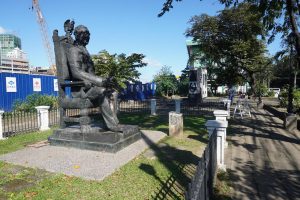Manila may be said to be the world’s first global city. As the site from where Spanish colonizers facilitated cultural and religious change in the Philippine Islands, Manila also existed as a mercantile emporium connected to different regions of Asia, Africa, the Americas, and Europe.
From the beginning, China was fundamental to Manila’s rise as a transcontinental hub. As an outcome of the Ming Dynasty’s conversion to silver currency, galleons sailed annually from Mexico to Manila, laden with vast quantities of the metal. In return, the Chinese exchanged precious merchandise. Sailing across the Pacific Ocean until 1815, the galleon trade operated as the mainstay of Manila’s economy and led to the establishment of a substantial Chinese community within the city.
Today, Manila has an urban and peri-urban population of more than 25 million people. Being the locale where more than one-third of the Philippine national economy is grounded, the investment, commerce, and business happenings that transpire within its bounds have national corollaries. Significantly, just as in the past, the present-day Chinese role is weighty.
As part of President Rodrigo Duterte’s goal of malasakit (enhancement of the social fabric), pagbabago (reducing social inequality), and kaunlaran (increasing growth potential), robust ties between Manila and China’s Belt and Road Initiative (BRI) have been forged. With the scheme corresponding to the Duterte government’s infrastructure development plan known as “Build, Build, Build,” an apparent “spring time” of bilateral economic cooperation has resulted.
As a symbol of this collaboration the Binondo-Intramuros Bridge is being built. Paid for by the Chinese government it will link Manila’s Chinatown to the historic Spanish walled city (known as Intramuros) and so, it is claimed, revive the glory of the galleon trade.
Yet for those concerned about built cultural heritage, the bridge’s construction into Asia’s best surviving example of a medieval walled settlement has provoked indignation. Given contemporary Philippine governance emphasizing property and infrastructure development as staples of economic growth, built heritage has become a casualty rather than a facet of present-day Manila culture and modernization. In view of this, efforts to preserve the historic urban fabric have been perceived by the elites as obstacles to societal advancement.
Ian Morley is an associate professor in urban history at the Department of History, Chinese University of Hong Kong.
















































